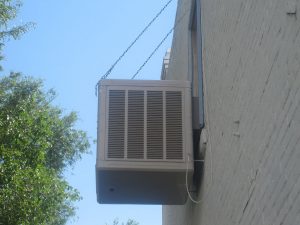General History of the Evaporative Cooler
- Evaporative cooling was used in principle in ancient China, Egypt, India and Iran. Servants would fan air over water jars.
- Leonardo da Vinci experimented with a fan-driven cooling system.
- In the Southwest, the Spaniards draped a mesh of cactus fibers or grass over clay water jars (ollas).
- When there was a breeze this would help cool the air. Early Anglo settlers would hang the ollas in a doorway or window to help improve the coolness. Early settlers also hung wet burlap at the top of wall openings.
- When electric fans were introduced, wet sheets were put in front of the fan to cool down the air. (This happened about 1917.)
- Also in the early 1900s, settlers would make their own crude coolers.
- Oscar Palmer of Phoenix is credited with the invention of the evaporative cooler. In 1908 he built the first drip type evaporative cooler in Arizona.
- By 1933, thousands of homemade coolers had appeared in Arizona. Two University of Arizona professors, Martin Thornburg and Paul Thornburg, circulated mimeographed instructions on how to build and use evaporative coolers.
- By 1936, the major manufacturing center for evaporative coolers was Phoenix, Arizona. The five largest cooler manufacturers in Phoenix were: Palmer Manufacturing, International Metal Products, Polaraire Cooler, Wright Manufacturing and Mountainaire Manufacturing.
For a detailed history of the evaporative cooler see “The Box that Broke the Barrier: The swamp cooler comes to Southern Arizona.” Journal of Arizona History. Summer 1985, Pages 163-173.
Why Is It Sometimes Called a "Swamp Cooler?"
The exact origin of the name is not known. Contractor Julian Hayden who built a box said,” If it wasn’t looked after, an early box became a miniature marsh. Bugs and fungus would grow in the wet pad or in the drainage under a window box. This would smell like a swamp."
Water Usage
There is a debate on how much water coolers use. Data for evaporative cooler water use are scarce since little research on this topic has been undertaken, and many factors, from household composition to location of the cooler, influence cooler water use.
- In Cool Houses for Desert Suburbs, opens a new window, Jeffrey Cook, a Phoenix architect, estimates that a 4500 CFM (cubic foot per minute) cooler, under certain weather conditions, uses 200 gallons of water per day.
- On the other hand, in a television interview in Tucson in September 1990, a Tucson Water Company employee stated that an evaporative cooler adequate to cool a 1,500 square foot home uses approximately four gallons of water per hour or 96 gallons per day, an estimate 50 percent lower than Cook’s.
- Further, the Arizona Department of Water Resources estimates that a typical Tucson household cooler uses a year-round average of 16 gallons per day.
- Recently, a research study was initiated by the Office of Arid Lands Studies at the University of Arizona and the Water Services Department at The City of Phoenix with funding from the Arizona Department of Water Resources. This study monitored evaporative coolers at 46 homes in Phoenix. The preliminary data from this study indicates that water usage of an evaporative cooler in Phoenix was about 7.6 gallons for each hour that the cooler was operated (4.4 gallons per hour for systems without bleed-off and 10.4 gallons per hour for systems with bleed-off).
- Another sources state that the evaporative cooler uses 9,000 gallons of water a year and 40 gallons of water a day. Yet another that each cooler uses an average of 30,000 gallons of water each year.
Selecting an Evaporative Cooler
For more information about evaporative cooler water use and tips on selecting a cooler, see the Arizona Cooperative Extension publication Evaporative Cooler Water Use (PDF) or the Department of Energy’s guide to evaporative coolers.
Sources:
Cook, J. (1979). Cool houses for desert suburbs: optimizing heating & cooling for Arizona builders. Phoenix: Arizona Solar Energy Commission.
Cooper, Gail. Air-Conditioning America: Engineers and the Controlled Environment 1900-1960. Baltimore: Johns Hopkins University Press, 1998. Pages 176-178.
“The Box that Broke the Barrier: The swamp cooler comes to Southern Arizona.” Journal of Arizona History. Summer 1985, Pages 163-173.
SAHBA Builder 7-1987. Page 11. (PCPL does not subscribe to this periodical.)
"Thirsty swamp boxes to vanish from roof?" Tucson Citizen. April 29, 2006. Page 1.
Karispac, Martin, & Marion, Mary H. “Evaporative Cooler Water Use.” Arizona University Extension. The University of Arizona, 1991.
Find the information you need by calling the library's Infoline at 520-791-4010 or by sending your question to Askalibrarian.

